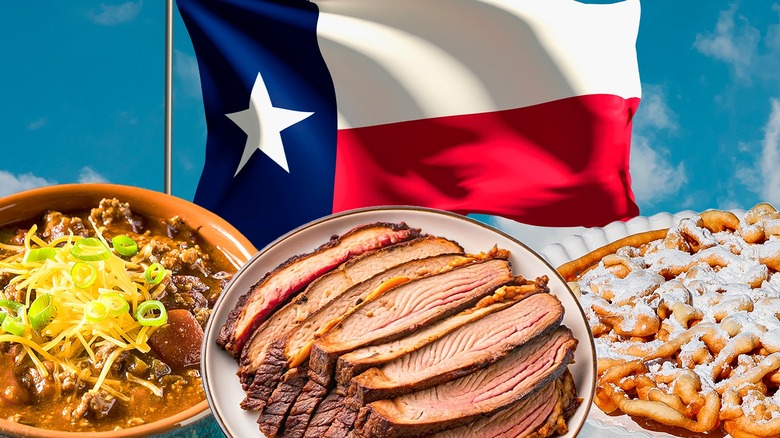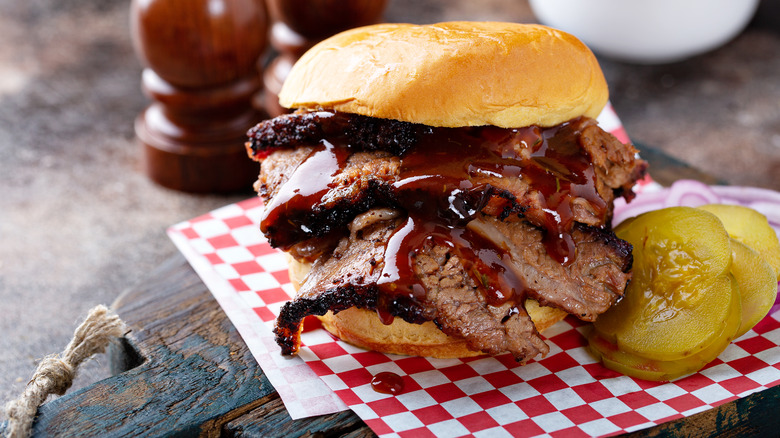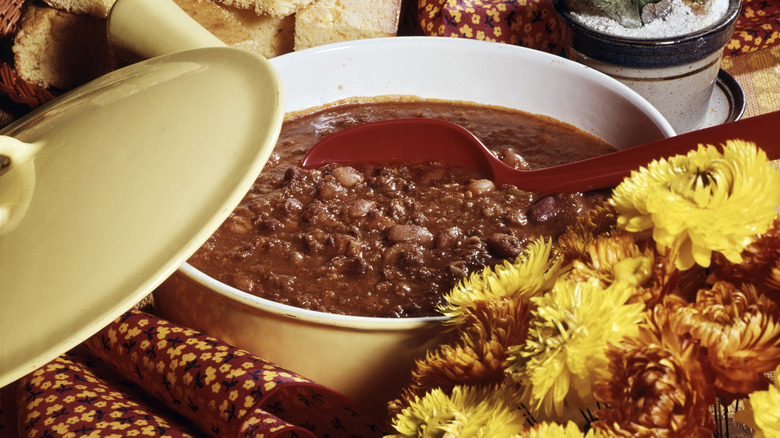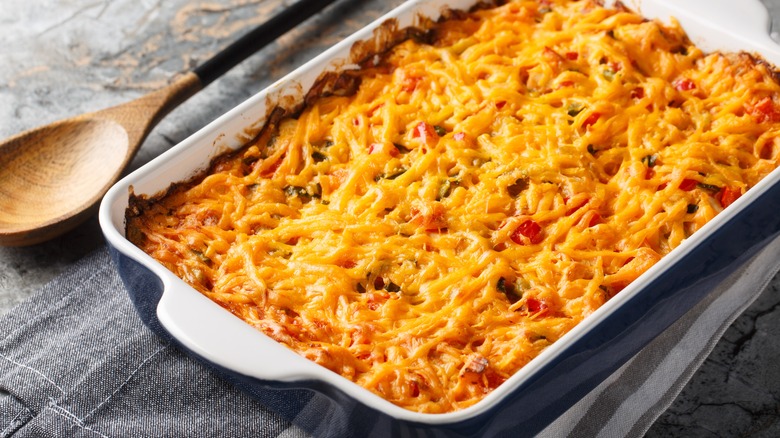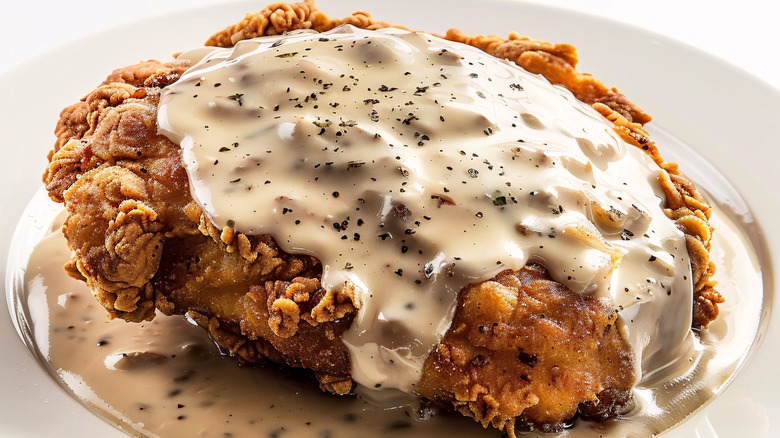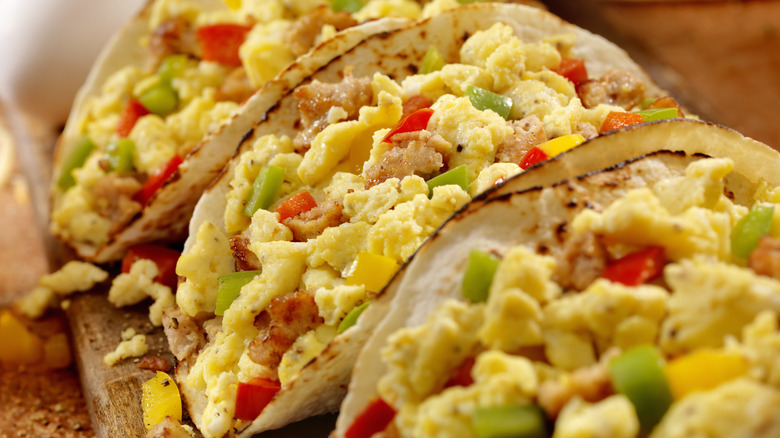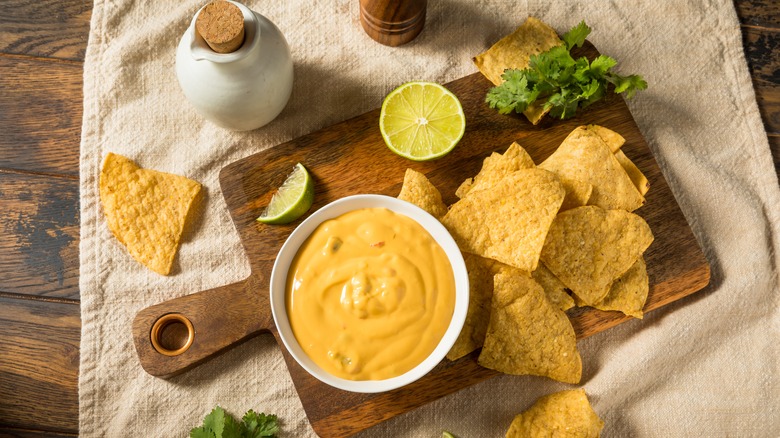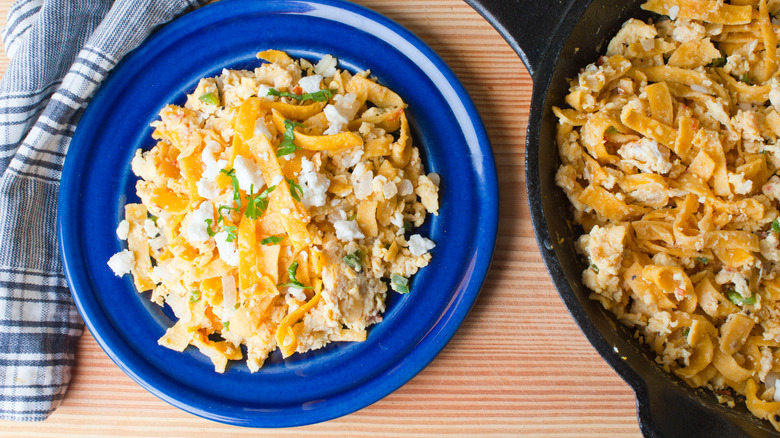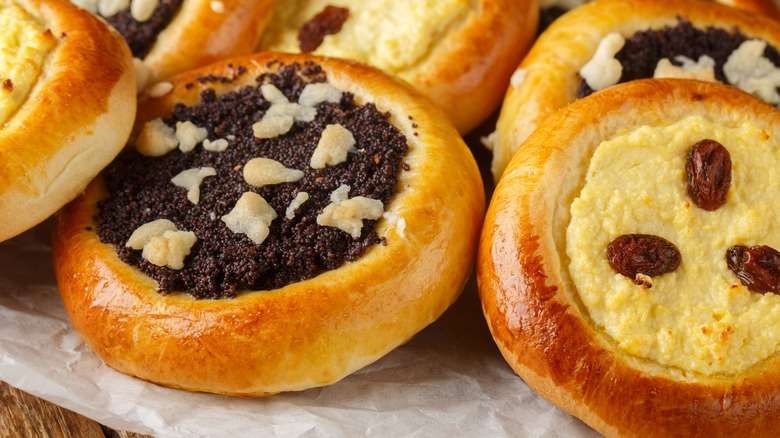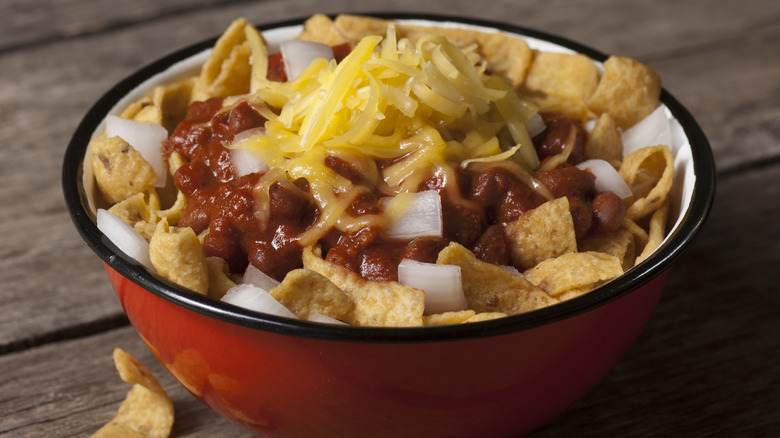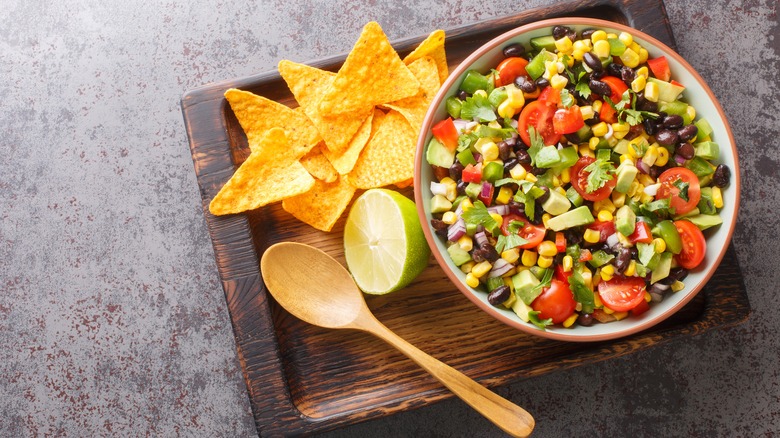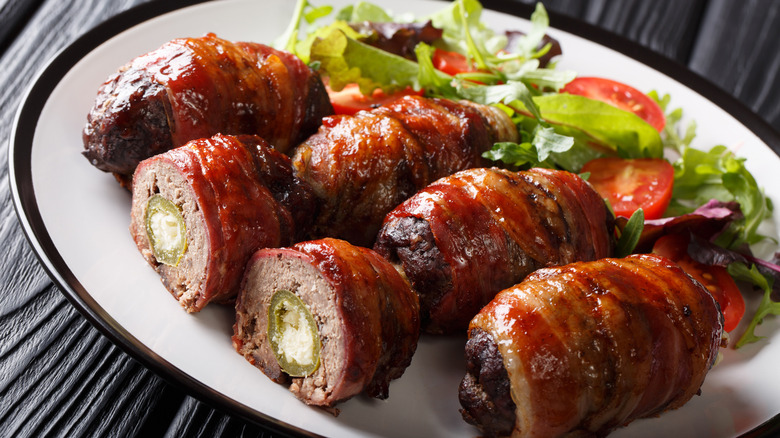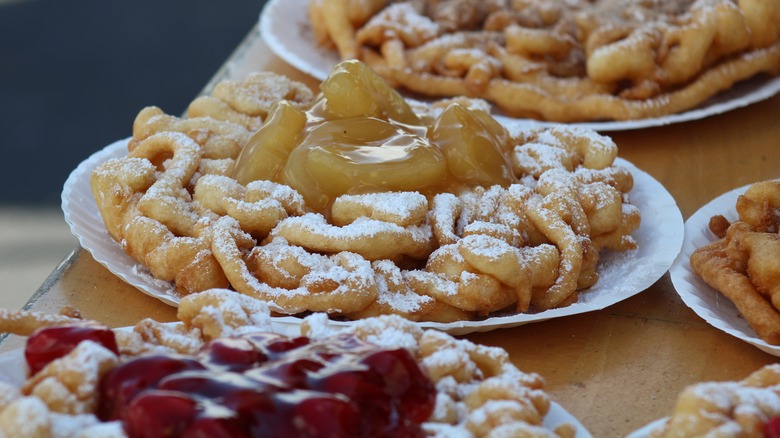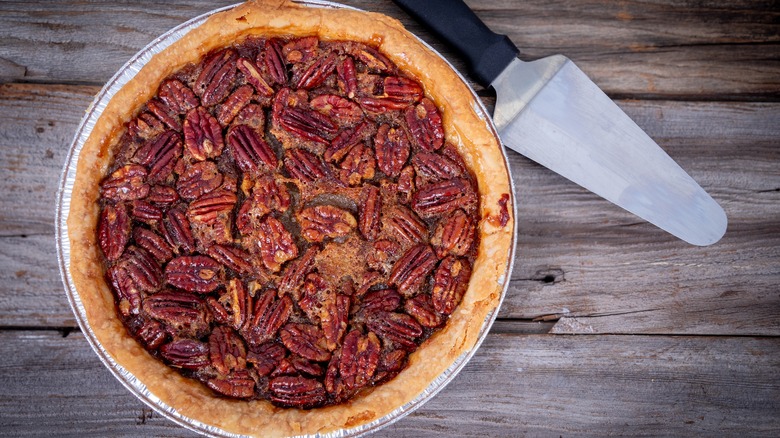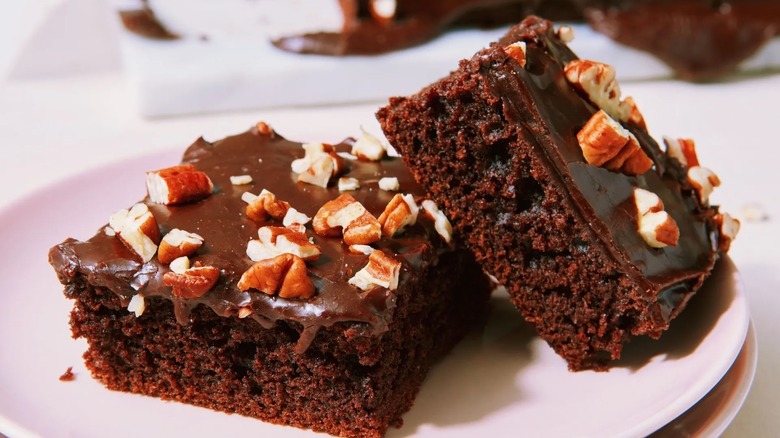14 Iconic Texas Foods You Must Try At Least Once
We may receive a commission on purchases made from links.
As a Phoenix native and fan of classic Mexican cuisine, I'll admit — I initially struggled adjusting to Texas fare. It's all about big portions, bold flavors, and heaps of cheese, meat, rich gravies, and heavy creams. But after more than a decade of being immersed in Austin's Tex-Mex and food truck scene, I've come to appreciate — and downright crave — Texas food for what it truly is: a big, bold melting pot of cultures. Texas dishes are synonymous with comfort, nurturing, and gathering. In fact, many of the dishes mentioned here are served in generous sizes because they're meant to be shared and enjoyed with loved ones (and because everything really is bigger in Texas).
Texas is famous for its smoky, tender barbecue, meat-heavy chili (no beans allowed!), and cheese-smothered Tex-Mex. Breakfast tacos are a daily morning ritual, chicken-fried steak is the ultimate comfort food, fudgy sheet cake is a potluck staple, and ooey gooey pecan pie isn't just reserved for holiday spreads.
With influences from Mexican, Czech, Jewish, and Southern traditions, Texas food is a delicious blend of the familiar and the unexpected. So, grab a plate and let's dig into this lineup of iconic Texas eats that are sure to make your taste buds do a happy dance — or a two-step, because, hey, this is Texas.
Beef brisket
Like many iconic Texas dishes, brisket made its way to the Jumbo State thanks to immigrants. As Texas Monthly, explains, the tender, smoky meat was especially popular among Eastern Europeans, particularly Jewish settlers, due to its kosher cut and its ability to feed large groups of people. With Texas' abundant cattle scene, the state became the perfect place to bring brisket to the masses.
The appeal of Texas brisket lies not only in its mouthwatering flavor — achieved by smoking the meat on low heat for hours — but also in the communal experience it represents. In Texas, barbecue isn't just a meal; it's an event. Families, friends, and communities gather around smokers, waiting for the brisket to reach perfection. You can technically smoke brisket indoors, but it's this shared anticipation, combined with the aroma of smoked post oak or mesquite, that's as much a part of the experience as the food itself. It's why people line up for hours at the legendary Franklin BBQ in Austin, 5,000 people visit Lockhart, Texas barbecue joints weekly, and Texas A&M offers Brisket Camp as part of its Meat Science program.
Traditional Texas brisket is seasoned simply with salt and pepper, letting the natural flavors of beef and smoke shine, but other spice combos, like in this barbecue brisket and cowboy butter recipe, can boost the flavor, too. Devour it alongside simple sides like coleslaw, pickles, and a slice of white bread, or load it onto a soft, buttery bun with barbecue sauce.
Chili con carne
Texas chili, or chili con carne, has been the state's official dish since 1977, making it even more iconic than barbecue! What makes it so memorable? As with many Texas dishes, it's all about the meat. The debate over whether chili should have beans is spicier than a ghost pepper, but Texans are clear: No beans allowed in these bowls.
For purists, beans dilute the flavor and distract from the star of the show: the beef (this is the Beef State, after all). Texas chili focuses on heaping portions of meat — typically tougher, highly marbled cuts that break down slowly, like chuck — along with a mix of spices like cumin, garlic, and sometimes cinnamon or cocoa for added depth. Tomatoes or tomato paste often show up, and the heat comes from a mix of chili peppers unique to each recipe. The result is a hearty bowl of tender beef with a deep, smoky flavor.
The origins of Texas chili are disputed, with theories ranging from Spanish settlers and Mexican cowboys in the 1800s to influences from Indigenous Americans and Canary Island immigrants. Regardless, the meat-heavy version, like this chili con carne recipe, became a staple at San Antonio's "Chili Queens" stands in the late 19th and early 20th centuries, where vendors served steaming bowls to locals and travelers. Today, Texans celebrate their version at family gatherings and cook-offs, with the first state contest held at the 1952 Texas State Fair.
King Ranch casserole
This creamy, cheesy, and mildly spicy dish is all about comfort, flavor, and convenience. Named after the largest ranch in the U.S., the King Ranch casserole is basically a Tex-Mex lasagna, made by layering corn tortillas, shredded chicken, a rich sauce, and plenty of cheese. The sauce typically combines canned cream of mushroom and cream of chicken soups, Ro-Tel tomatoes, and a dash of chili powder for that classic Tex-Mex kick.
Its hearty ingredients and simple prep make it a hit at potlucks and family get-togethers. Just layer it all in a casserole dish, toss it in the oven, and you've got a flavor-packed meal ready to go. You can easily customize it with extras like bell peppers, onions, or jalapeños, and even double up on the recipe without a hitch.
The true origins of King Ranch Casserole are shrouded in a bit of mystery. Despite its name, it probably didn't originate on the King Ranch, which is famous for its beef. Plus, the King family hasn't taken credit for the dish. More likely, it was dreamed up by clever home cooks in the 1940s or '50s, embracing the convenience of canned soups. Whatever its beginnings, King Ranch casserole has earned its spot in Texas culinary legend, with its big flavors, hearty portions, and no-fuss, crowd-pleasing appeal. Ready to give it a go? Start with this simple from-scratch recipe!
Chicken-fried steak
Despite its name, there's no chicken here — just a tenderized beef steak, usually a budget-friendly cut like cube steak, that's floured or battered and fried to crispy, golden perfection, just like fried chicken. The stick-to-your-ribs dish is usually smothered in creamy, peppery white gravy and often served with mashed potatoes or buttery biscuits (green beans or corn if you want to risk switching things up). What's left is a dish that's big, hearty, comforting, and unapologetically indulgent (a bit like Texas itself).
There's some debate about where chicken fried steak first hit the plate. One popular myth, noted in Food Timeline, suggests that it was born out of a mistake in 1911 when a short-order cook in Lamesa, Texas, battered and fried a steak instead of chicken. The story has since been debunked, but it didn't stop the city of Lamesa from claiming to be the "Legendary Home of the Chicken-Fried Steak" and holding a festival each year to commemorate its creation. Other records point to German and Austrian immigrants possibly inspiring the dish when they brought their traditional breaded cutlets to Texas and home cooks later added their own twists.
Regardless of its origins, chicken fried steak is now a staple at diners, cafes, and family kitchens throughout Texas. Texans have even taken their love for the meal to the next level by officially declaring every October 26 Chicken Fried Steak Day. Want to bring that diner-style flavor home? Give this diner-style chicken-fried steak a try!
Breakfast tacos
Forget bacon and eggs, y'all — breakfast tacos are the true breakfast of champions in Texas. Picture a soft, warm tortilla packed with scrambled eggs, cheese, and any other toppings you crave — crispy bacon, spicy chorizo, sautéed veggies, creamy avocado, or refried beans. Top them off with a sprinkle of cheese, a dollop of salsa, and maybe a dash of hot sauce, and you've got a breakfast that packs a punch all in one neat, portable package. They're like mini breakfast burritos but quicker and arguably tastier.
Breakfast tacos trace their origins to northern Mexico, inspired by dishes from Monterrey and beyond, but who coined the term "breakfast tacos" has sparked heated debate, with both Austin and San Antonio vying for the credit. Despite their popularity now, breakfast tacos weren't always embraced, at least as the history in told in Austin. Decades ago, segregation of Mexican families and restaurants in Austin made eating tacos a source of ridicule or even shame. But as Texas' culinary scene evolved, tacos went from being mocked to becoming a beloved staple across the state.
Whether it's from a popular taco chain like Torchy's or Tacodeli, a local taco truck, a coffee shop, or even a gas station, breakfast tacos are now literally everywhere and don't seem to be waning in popularity. You can also make a batch at home with whatever's in your fridge (like this Wrangler breakfast taco). Bottom line: Breakfast tacos are a versatile, tasty way to start your day.
Tex-Mex queso
In Texas, queso isn't just a dip — it's a lifestyle. This melty delight is a must-have at parties, game days, happy hours, and Tex-Mex joints. Just don't call it "cheese dip." In Texas, queso is practically its own food group: a hot, creamy blend of gooey cheese with a spicy kick.
The classic recipe often starts with Velveeta and Ro-Tel (tomatoes and green chilies). From there, anything goes — jalapeños, onions, ground beef, chorizo, or even brisket. Some versions, like this smoky white queso dip, use real cheeses like American, cheddar, or Monterey Jack, which can blur the lines between Texan queso and the more sophisticated queso fundido. The result? A smooth, melty concoction perfect for scooping with warm, crispy tortilla chips.
Queso's charm lies in its versatility. Use it as a dip, pour it over nachos, or drench your enchiladas in it. Legend has it that President Lyndon B. Johnson loved chiles rellenos smothered in queso from Austin's iconic Matt's El Rancho so much that he had them flown into Washington, D.C.
Queso's Texas roots trace back to the early 20th-century, merging Mexican traditions with American ingredients. According to Lisa Fain's cookbook, "QUESO!," the Woman's Club of San Antonio published a recipe for "chile con queso" in the 1920s, and Lady Bird Johnson's personal recipe appeared in The Washington Post in 1964. By the 1980s, Velveeta and Ro-Tel were popularized as the essential queso ingredients, making it a staple for home cooks and restaurants alike across Texas.
Migas
In Texas, if you're not devouring a taco for breakfast, you're likely enjoying migas (or to really fit in, a migas breakfast taco). This hearty Tex-Mex classic takes scrambled eggs to the next level by mixing in crispy tortilla strips, onions, tomatoes, and jalapeños. Many versions throw in cheese (because why not?), and extras like chorizo and salsa for an extra kick. The best part? Everything cooks together in one pan, blending all those delicious textures and flavors into every bite.
Migas are popular for a few good reasons. They're quick and easy to whip up, making them a go-to choice for busy mornings and long brunches. They also make great use of leftover tortillas, and they're customizable — spice them up, tone them down, make them veggie-friendly, or load them with meat. The sky's the limit.
The origins of migas can be traced back to Spanish, Portuguese, and Mexican cuisines, where different versions of the dish have been savored for centuries as a clever way to repurpose stale bread. Traditional Spanish migas, for instance, often mix bread crumbs with chorizo and grapes for a refreshing contrast of flavors. Texans carved out their own identity with a classic Tex-Mex version, and now you can find migas on the menu of just about every breakfast restaurant and diner around the state. Want to try making a batch? Take a cue from one of Texas' most popular taco chains, Tacodeli, and follow these steps to make mouthwatering migas tacos.
Kolaches
Kolaches (pronounced ko-LAH-chee) are the sweet, sometimes savory pastry gems of the Lone Star State. Originating from Czech immigrants who settled in Texas in the 1800s, these doughy delights have become a breakfast staple and snack-time favorite across the state. There's even a designated "Texas kolache trail" that runs along I-35 between Dallas and Austin, where travelers can explore a variety of the delicious handmade treats. (If you can't make it, kolaches are served up just about everywhere, even in coffee shops and convenience stores.)
The traditional kolache is a sweet, yeast-based dough, usually filled with fruit preserves like apricot or prune, with poppyseeds, or with sweetened cheese, like in this sweet kolache recipe. Over time, Texans put their own spin on this Old World treat, crafting savory versions filled with breakfast sausage and jalapeños, ham and cheese, or smoky bacon and eggs. There are even rolled versions resembling "pigs in a blanket" that some call "klobasniky," but most Texans just refer to every variation as a kolache. Modern kolache menus feature a variety of fun and unique fillings. Take Koala Kolache in Cypress, Texas, for example, where you can find everything from a Thanksgiving Dinner kolache to others filled with chicken enchiladas, crawfish étouffée, or bulgogi kimchi.
Kolaches' charm lies in their simplicity and the comfort they bring, evoking memories of home, family gatherings, and small-town bakeries. And in Texas, kolaches aren't just a treat — they're a testament to the diverse flavors that make Texas unique.
Frito pie
Despite being dubbed "warm crap in a bag" by the late, legendary chef Anthony Bourdain, Frito pie remains a reigning champion of comfort food in Texas. This delightfully messy, straightforward dish starts with a bed of crunchy Fritos corn chips, piled high with spicy chili and topped with a generous sprinkle of shredded cheese, diced onions, and jalapeños. For an extra kick, some folks add a dollop of sour cream or a splash of hot sauce. The end result is a warm, gooey, and crunchy masterpiece that perfectly hits all the right notes.
The origins of Frito pie spark plenty of debate, with several states claiming the title of birthplace. Some credit Texas' Katherine Doolin, whose husband Charles Elmer Doolin created Fritos in the 1930s, with inventing the dish. Meanwhile, others point to a Woolworth's lunch counter in Santa Fe, New Mexico, during the 1960s as the original source. (This red chile version of Frito pie has since become a Sante Fe favorite.) In the Midwest, the dish has evolved into what's often called a "walking taco," where all the ingredients are mixed right in the bag.
Regardless of where it began, one thing is clear: Frito pie is a beloved, comforting treat enjoyed across the country. It's the perfect food for game days, county fairs, and tailgating parties — anywhere you need a tasty, portable snack. Plus, it's super easy to make: Grab a bag of Fritos, ladle on some chili, and you're good to go!
Cowboy caviar
Is it a dip? A side dish? A taco topping? It's all of the above! Cowboy Caviar stands out on our list of iconic Texas foods as a hearty yet light dish, absent of many traditional Texas ingredients like meat and cheese. Think of it as a zesty bean salad with a Tex-Mex twist: a fresh, colorful dip brimming with black-eyed peas, black beans, corn, diced tomatoes, onions, and bell peppers. It's all tossed together in a tangy vinaigrette with a squeeze of lime juice and a dash of cilantro, making each bite burst with flavor.
Credit for the cheeky name goes to Chef Helen Corbitt, who helped shape the culinary scene in Texas for four decades. She invented the dish in 1940 and initially labeled it Texas Caviar as a playful way to compare the dish's beans with the pricier roe that real caviar calls for. Although the name evolved over time to Cowboy Caviar, this salad of sorts has remained a beloved part of Texas cuisine and gained fans all across the country.
Perfect for scooping up with tortilla chips or enjoying straight off the spoon, Cowboy Caviar couldn't be easier to whip up — just chop, mix, and serve. It's also a great way to highlight fresh, seasonal ingredients and can easily be adapted. Try this Cowboy Caviar recipe at your next potluck or party, and watch it become a hit!
Armadillo eggs
No armadillos are involved in the making of these party favorites — just a delicious combination of spicy, cheesy goodness. These bite-sized treats start with your quintessential jalapeño popper — a jalapeño pepper cored and stuffed with a creamy blend of cheese, usually cheddar or cream cheese, sometimes with a bit of sausage mixed in for extra flavor. The stuffed jalapeño is then typically fully encased in bacon (while others prefer a bread crumb coating), forming an egg-like shape, and baked or smoked until everything is perfectly cooked and the flavors meld together. The result? A smoky, spicy, cheesy delight that's crispy on the outside and gooey on the inside.
It's not entirely clear where armadillo eggs first emerged, but they likely evolved from a fusion of Southern cooking traditions and Tex-Mex flavors, while drawing inspiration from the English Scotch egg. One of the first known references to armadillo eggs appeared in a 1972 article from the Victoria Advocate about an upcoming armadillo festival in Victoria, Texas.
Today, these cheesy, spicy bites have become a staple in Texas culinary culture, winning over taste buds with their irresistible mix of heat, crunch, and gooey cheese. Whether at backyard barbecues or tailgate parties, armadillo eggs are always a hit and disappear fast, proving that, for Texans, everything really is better with bacon.
Funnel cake
Funnel cake is a must-have at Texas carnivals, rodeos, and festivals. Imagine a golden, crispy web of deep-fried dough, dusted with powdered sugar and served hot. The dough is swirled through a funnel into hot oil, creating a crispy, airy delight that's sweet, crunchy, and slightly chewy. While some top theirs with strawberries, chocolate syrup, or ice cream, the classic powdered sugar version is always a winner.
Funnel cake's roots reach across Europe, with influences from German, French, and Middle Eastern cuisines. Brought to America and popularized by German immigrants called the Pennsylvania Dutch, the fluffy, crispy treat later became a fairground staple, starting in Pennsylvania and stretching across America.
The funnel cake makes our iconic Texas foods list, however, thanks to Wanda "Fernie" Winter, the Funnel Cake Queen, who introduced her crispy, sweet version to the Texas State Fair in 1969 and sparked a decades-long tradition. Though Fernie died in 2021, her legacy lives on through her family, who continues to serve up the classic funnel cake and inventive treats. Today, funnel cake isn't just a dessert; it's a symbol of Texas fun — a crispy, sweet, handheld snack that's that captures the spirit of balmy summer nights, lively midways, bustling fairs, and dusty rodeos.
Want to skip the carnival and make your own funnel cake? Try this simple funnel cake recipe! Featuring buttermilk pancake mix as the main ingredient, it's a delicious and straightforward way to enjoy this classic treat at home.
Pecan pie
This Texas staple isn't just a holiday table staple — it's a classic you'll find on every regional diner's dessert menu. The sweet, nutty pecan pie features a buttery, flaky crust filled with a rich, gooey mixture of pecans, eggs, sugar, and corn syrup. Each bite offers a satisfying crunch from the roasted pecans, balanced by the silky, caramel-like filling that's sweet without being overwhelming. It's a simple pie but one that delivers a decadent flavor.
Pecan pie's popularity in Texas makes perfect sense, as pecans are the state's official nut and are native to the region. Pecan cultivation took off in the 19th century thanks to Antoine, an enslaved man who revolutionized pecan farming, and the pie itself began appearing in Southern cookbooks in the late 1800s. Its rise to national fame in the early 1900s was fueled by the introduction of Karo Corn Syrup, which gave the pie its signature gooey texture and helped cement it as a beloved American dessert by the 1940s.
Today, pecan pie is all about Texas tradition and that cozy, homey feeling that brings families together. Whether it's at a backyard barbecue or a holiday feast, this pie celebrates the state's agricultural bounty and Lone Star pride, making it a true favorite. Ready to make this Texas classic? Try this pecan pie recipe, and don't forget to top it off with a dollop of whipped cream or a scoop of vanilla ice cream.
Texas sheet cake
All function and no frill, the Texas sheet cake is beloved for its simplicity, richness, and ability to feed a crowd. That's why it's a go-to for potlucks, picnics, and family gatherings. In fact, the cake is also often called "Texas funeral cake," thanks to its ability to bring comfort to the masses.
No fancy ingredients or complicated steps are required — just basic pantry staples like cocoa powder, buttermilk, and butter (like in this classic chocolate cake recipe). You can also get creative with flavors, like this gochujang Texas sheet cake. Baked in a large, shallow pan, the cake comes out thin, moist, and perfect for slicing. What really sets Texas sheet cake apart is its warm, fudgy icing poured over the hot cake, soaking into the surface for a gooey, almost brownie-like texture. Top it with crunchy chopped pecans to keep to tradition.
Even the name of this cake sparks debate. It might come from its Texas-sized dimensions — baked in a larger-than-usual sheet pan (10x15 or 12x18 inches) — or from the pecan topping. A popular myth that Lady Bird Johnson named the cake has since been debunked. The recipe itself has been traced back to a 1936 chocolate cake recipe from Galveston, a 1957 submission to the Dallas Morning News, and even a 1967 Alabama cookbook. Its real rise to fame came in the 1980s when it started appearing in regional cookbooks, solidifying its place as a symbol of Southern hospitality.
